The Jewish Traveler
Feature
The Jewish Traveler: Macedonia
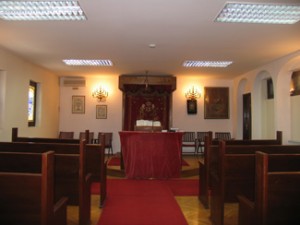
A new, 30-ton bronze statue of Alexander the Great towers over Skopje’s central square. The statue is part of Skopje 2014, a $102-million project that includes a triumphal arch, some 20 new buildings and about 20 statues and monuments.
On one side of the square a round, glass-faced office tower echoes the shape of the statue’s pedestal. On the other side is the colonnaded neoclassical Museum of Archaeology, rebuilt as it was before a 1963 earthquake leveled most of the city. On the third side, narrow lanes wind through the old Turkish bazaar where souvenir stores have replaced artisans’ workshops and where a traditional Turkish coffeehouse faces the Bourbon Street pub. The fourth side is the Vardar River, which cuts through Macedonia from north to south.
The jumble of past and present and the ambitious cultural project reveal Macedonia as a country trying to forge a modern national identity by reaching into the distant past. This small, landlocked republic, ringed by mountains and only slightly larger than Vermont, was once part of the Macedonian Empire. But its name—identical to that of a neighboring region in northern Greece where Alexander the Great was born—and its claim to Alexander as its own national hero have generated a dispute between the two countries that is threatening Macedonia’s entry into the European Union.
This year, the Jewish community marked the 70th anniversary of the deportation of nearly all Macedonia’s Jews to Treblinka, from which none returned.
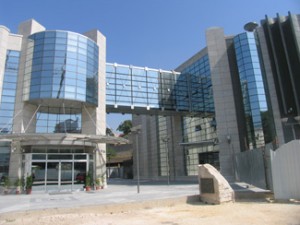
History
Jews lived throughout the Balkans in antiquity, so it is no surprise that evidence of Jewish life has been found in Macedonia. Philo, the 1st century C.E. philosopher, mentions their presence there, and the apostle Paul preached in their communities.
An inscription and two synagogues found in the ruins of Stobi, 50 miles southeast of Skopje, attest to a Jewish community from at least the third century C.E. Stobi, and later Bitola, were important cities on the Via Egnatia, a trade route that connected the Albanian port Durazzo (Durres) with Thessaloniki and Constantinople.
Until 1492, most of Macedonia’s Jews were Greek-speaking Romaniotes. In Bitola in the 12th century they were artisans and traders; they also lived in Skopje, Ohrid and Struga. The first-known synagogue in Skopje dates to 1366. From 1389, the Ottomans started developing Skopje as a commercial center; by the 16th century, a Jewish cemetery existed and the inhabitants of the Jewish quarter were tanners, smiths and exporters of wool.
Jews expelled from Hungary came to Bitola (called Monastir under the Ottomans) in the 14th century, and refugees from Asia Minor came in the 15th.
In the 16th century, Jews expelled from Spain and Portugal swelled the communities in several Macedonian cities; and, in the 17th century, Marranos from Holland and elsewhere settled in Skopje. In 1689, Skopje had 3,000 Jews. Jews from Thessaloniki settled in Shtip.
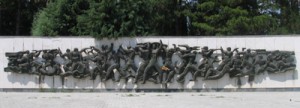
From the 14th century to the early 20th, Jews took an active part in commerce as importers and exporters in Bitola, which in the late 19th century was the second-largest city in the southern Balkans. They also worked in trades, including tanning and as silversmiths. But in Skopje in the 19th century, newly arrived Serbs elbowed the Jews out of commerce, causing a drastic economic decline in the community.
In 1910, 7,000 Jews lived in Bitola. They suffered starvation and bombardment during World War I, when that city was on the frontline, and many left after the war because the economy deteriorated; those who remained were very poor, but they had a rich culture that included the Judeo-Spanish language. Intensive Zionist activity began in the 1930s.
On the eve of World War II, some 3,350 Jews remained in Bitola, about 3,800 in Skopje and 550 in Shtip. In March 1941, Bulgaria agreed to let German troops enter its territory to attack Yugoslavia and Greece; in return, the victorious Germans gave the Bulgarians Thrace and Macedonia, which had once been Bulgarian provinces. Bulgaria enacted anti-Jewish measures, passing laws modeled on the Nuremberg laws, confiscating property, levying a heavy tax, denying Bulgarian citizenship to Jews in the provinces, forcing Jews into ghettos and slave labor camps and, in February 1943, agreeing to deport 20,000 Jews to death camps in Poland. Protests by the public, politicians and the church saved the Jews in “old Bulgaria,” but was too late to save the Jews of Macedonia and Thrace.
Of more than 600 Macedonian Jewish applicants, the partisans accepted only 69, 14 of whom fell in battle. In March 1943, the Bulgarians concentrated the Jews of Shtip, Bitola and Skopje—half of them under the age of 18—in the Monopol tobacco factory in Skopje, near a railroad line, where they were held without sufficient food, water or sanitation facilities. Within three weeks, 7,144 Jews were deported to Treblinka. The two percent who escaped deportation had fled, hidden, joined the partisans, held Spanish or Italian citizenship or were doctors or pharmacists.
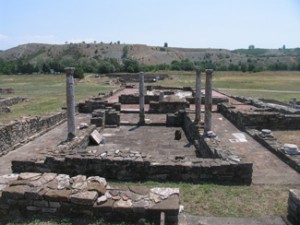
Today, the only Jewish community is in Skopje, and it is a tiny fraction of a country of about two million that is two-thirds Slavic (Orthodox Christian) and nearly one-third Albanian (Muslim).
Community
Traditionally, the Sefardic women of Macedonia received their guests with homemade preserves of seasonal fruits: apricots, plums, peaches, quince, watermelon peel and, on Rosh Hashana, white cherries to ensure a bright year. Sefardic cuisine is still prized by Macedonia’s Jewish community, which numbers about 60 families, mostly Sefardic, with some 50 children. Jews are well-educated and work as doctors, lawyers, teachers and professors, businesspeople and in high tech.
On Rosh Hashana, Yom Kippur, Passover and Hanukka, a cantor comes from Sofia, and sometimes a rabbi comes from Thessaloniki to lead Sabbath services. Several times a year families gather for a communal Sabbath meal at the Jewish center, which has a kosher kitchen.
Children attend Sunday school, where they also learn Hebrew, and Jewish summer camp. Other activities include weekly meetings of Isha, the women’s club, whose members make crafts and cook holiday meals; a children’s club; a young adults’ club; athletics under the auspices of Maccabi; Hebrew classes for adults; and a choir, whose main goal is to preserve the Sefardic romansas.
The best way to contact Skopje’s Jewish community is through it secretary-general, Jana Nichota (011-389-75-210-235; contact@ezrm.org.mk).
Sights
SKOPJE
The Beit Yaakov Synagogue, the only Jewish house of worship in Skopje to survive World War II, succumbed to the 1963 quake. In the new Beit Yaakov, in the Jewish community center’s three-story building on a quiet side street, an embroidered red velvet curtain from the old synagogue covers the Ark. Stars of David ornament the dark wooden pews, and the stained-glass windows have traditional motifs, such as a Hanukka menora. Stars of David also decorate the fence surrounding the building, and a large eight-branch menora stands in the courtyard (24 Borka Talevski; 011-389-2-321-4799; ezrm@telekabel.net.mk).
The past looms large in the community’s identity, as is evident from the $23-million stone-and-glass Holocaust Memorial Center that opened in 2011. It is about a mile north of Beit Yaakov, near the city center and in the heart of the old Jewish quarter, which lay between the Stone Bridge and the fortress. It faces the Museum of the Macedonian Struggle and stands on what is today prime property on the Vardar River.
In an installation in the entrance, dozens of digital frames display some 3,200 photographs, many of them recovered from the Nazi registration book in Bitola. In the central atrium, a light sculpture inspired by the Burning Bush has 7,144 strands, one for each deportee. A boxcar of the Bulgarian National Railway along which Jews were transported to Treblinka stands in an adjacent room. The center also displays urns containing ashes from Treblinka.
An exhibition on the second floor tells the pre-Holocaust story of the Sefardic Jews who were the majority of Macedonia’s communities. Visitors can see two films, one on the Jews of Macedonia and the other about the Jewish partisans, especially Beno Russo and Roza Kamhi, who married after the war. Russo became the head of the anti-Fascist underground in Bitola and was a general by the end of the war. In 2014, the museum plans to open a new, traveling exhibition incorporating a section for children.
Groups of Macedonian pensioners, schoolchildren and university students as well as tourists visit the center, which also sponsors art colonies in which artists of all religions create works about the Holocaust. The gift shop sells crafts made by local Jewish women, books, Judaica and amulets.
A building connected to the memorial center is scheduled to open in the next few years as an arts center or institute of Sefardic Jewry (Goce Delchev Boulevard; contact Maja Susha for tours, 389-71-399-005; maja.susha@holocaustfund.org.mk).
Every year on March 11, the day the Bulgarians rounded up Macedonia’s Jews, the community holds a memorial service at the Monopol tobacco factory (today Imperial Tobacco). A plaque on the building, placed by the (anti-Fascist) Fighters Union of the National Liberation Movement, commemorates the Jews held there. In a garden in the compound, a stone memorial erected in 2004 holds two plaques, one in Macedonian and the other in Hebrew (125 11 Oktomvri Street; visits must be coordinated by the Jewish community).
After laying wreaths at the factory, community members proceed to the Jewish section of the Butel municipal cemetery, about five miles to the northwest, where a small structure with four Ionic columns and a gabled roof holds a plaque commemorating the deportees and those whose bones were moved from the old Jewish cemetery. The area in front of the structure is paved with broken tombstones rescued from the old cemetery after World War II. Community members also lay wreaths at the partisans’ memorial, in another section of the cemetery.
STOBI
An hour’s drive southeast of Skopje, Stobi was populated mainly from the first century to the sixth, when it was destroyed by an earthquake. The large site contains a theater, palaces, homes of wealthy families and beautiful fourth-century mosaics with animal motifs that were part of a baptistery.
A third-century inscription describes construction work on a synagogue. The donor was Klaudios Tiberios Polycharmos, whose family home was apparently adjacent to that synagogue, which had frescoed walls. In the fourth century, a synagogue with geometric-design mosaics and frescoed walls was built above the earlier synagogue, and in the fifth century a church was built on the later synagogue. According to guide Toshe Baleski, the columns visible at the site were part of the church; the fourth-century synagogue’s mosaics, which are undergoing conservation, can be viewed in the outdoor exhibition space at the far edge of the site.
Before World War II, Bitola, five miles west of Stobi, had six synagogues and two kosher butchers. Dozens of Jewish businesses lined the main commercial street, now a pedestrian mall officially called Marshall Tito Street but known by locals as the Korzo or by its Ottoman name, Sirok Sokak (wide street). At 24 Ruzveltova (Roosevelt) Street, off Sirok Sokak, stands the building that housed the Zionist left-wing youth movement Hashomer Hatzair, many of whose members joined the partisans.
Every March 11, a community delegation and the mayor lay wreaths at the memorial monument in the park that was once the center of the Jewish neighborhood and at the statue of fallen partisan Estreja (Mara) Ovadija, erected by the city near the local hospital, on the site where the Aragon Synagogue stood until it was destroyed during the war. Ovadija, noted for her courage, determination and endurance, was the only Jewish woman declared a national hero in Yugoslavia.
The former Monastir Military Academy, where Turkish leader Kemal Ataturk studied, is now the NI Institute and Museum Bitola (389-47-233-187; www.bitolamuseum.org. The site features a photo gallery with a collection of images titled Jewish Ethnic Identity Bitola, under permanent exhibitions). One wing dedicated to Ataturk displays a love letter to him from Eleni Karinte, who spent but one day with him and loved him all her life. In the archaeological exhibition, which contains altars and interesting pottery from 5500 B.C.E., a case displays objects from a Bitola synagogue: parts of a Torah scroll dating to the 15th century, a silver Torah finial and a votive hand. The museum also exhibits a partial list of the city’s deported Jews, an urn with ashes from Treblinka and photographs of partisans, including Estreja Ovadija and Josef Mordo Nachmijas.
The cemetery, in the Ushitçi neighborhood, has an ornate, Moorish-style entrance, with a pointed arch; stars of David ornament the fence. The elaborate tomb of Avram Aroesti, who died in 1939, is visible near the fence.
OTHER
No trip to Macedonia is complete without a visit to the resort town of Ohrid, on Lake Ohrid, near the Albanian border. Both the lake and the town, known for its multitude of churches and summer festivals of music and dance, are Unesco World Heritage Sites. Be sure to take the boat trip to the lagoons of Sveti Naum. Cyril and Methodius, two brothers who became Christian missionaries in the 9th century and were later canonized, are credited with having created the Cyrillic and Glaogolitic alphabets, the first script for the Slavic languages.
And Shtip, 60 miles southeast of Skopje, also has a memorial monument.
Books, Films
The Golden Mean by Annabel Lyon (Random House) portrays the seven-year teacher-student relationship between Aristotle and the young Alexander, son of Philip II.
Zamila Kolonomos describes Jewish holidays, life-cycle customs and other aspects of Sefardic Jewish life in Sparks of the Macedonian Sephardim, which also includes more than 170 recipes (published by the Jewish community and sold at the Holocaust Memorial Center).
Empty Boxcars is a documentary by Ed Gaffney on the survival of the Bulgarian Jews and the mass murder of the Jews of Thrace and Macedonia (available from Kehila Kedosha Janina synagogue in New York; www.kkjsm.org).
In The Third Half, directed by Darko Mitrevski, set during World War II and based on two true stories, a young woman from a wealthy Macedonian Jewish family is saved from deportation by eloping with her lover, a poor soccer player. Meanwhile, a soccer team coached by a German Jew becomes the champion of the Fascist-controlled Macedonian league. The film was shot in Skopje, Bitola, Shtip and Ohrid, and the last scene is set in the Holocaust Memorial Center.
Personalities
Ohrid-born Judah Leon Moskoni was a 14th-century philosopher and scholar who stated that to understand the Bible one must know grammar. He is known for his edition of the Hebrew Josippon, a popular 10th-century chronicle of general and Jewish history; his edition is still in use.
Nathan of Gaza was the key promoter of false messiah Shabbetai Zevi. Born in Jerusalem around 1643 to a respected rabbinical scholar with kabbalistic leanings, he married a woman from Gaza and moved there. Nathan died in Skopje and his grave became a pilgrimage site for Sabbateans. The tombstone was destroyed in World War II.
Recommendations
Macedonia’s climate is the most inviting in late spring and early fall. Major European airlines connect to Skopje’s Alexander the Great Airport, and an inexpensive shuttle will bring you into the city. Skopje can also be reached by bus from some European cities, for example, Sofia and Thessaloniki (www.simeonidistours.gr).
For information on touring general sights, check the country’s official tourism Web site (www.exploringmacedonia.com) or call 389-2-3080-111.
In Skopje, Hotel Ani (5 Borka Taleski) and Hotel Bimbo (63 29 Noemvri; www.hotelbimbo.com.mk) are within easy walking distance of Beit Yaakov Synagogue.
Macedonia has no kosher restaurants, but many restaurants offer vegetarian dishes, including delicate deep-fried zucchini flowers, cheese-stuffed red peppers, the ubiquitous shopska salad and various kinds of pasta as well as locally farmed trout. In Skopje you can find them on the menu of Skala, which has live music and faces City Park (88b Naum Naumovski Borce; 389-2-312-7095). Here you can also taste T’ga Za Jug, a fruity red wine named for a song of longing for the homeland written by a Macedonian abroad.
One of the loveliest places to relax is the Popova Kula winery (www.popovakula.com.mk), along Macedonia’s wine route, 16 miles south of Stobi. Vineyards and rolling hills surround the wine shop, restaurant and comfortable hotel. Take the Demir Kapija exit from E75 and follow the signs.
And in Skopje take a short drive into the forested slopes of Mt. Vodno to the St. Panteleimon church, which is famous for its unusual Byzantine frescoes that portray dramatic emotion. Next to the church is a restaurant with a terrace, where you can sip the local Skopsko beer and enjoy a view of the city.
Esther Hecht blogs about her travels at https://estherhecht.wordpress.com.










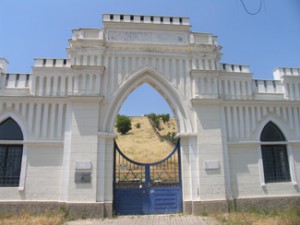
 Facebook
Facebook Instagram
Instagram Twitter
Twitter
Nick the Greek says
Macedon is Greek Kingdom same as Sparta is Greek Kingdom – Both are Dorian, and both Greek. If minor Slavic country today, stepped on to world stage and claimed the name of Spartan Kingdom for country-name…sovereign state-name, nationality, language and ethnicity – How should the West react to such anti-Hellenic action? anti-Western by extension. In the Western worlds long-established cultural-historical narrative, Sparta is Greek Kingdom same as Macedon, both Dorian, both Greek. Who could argue otherwise. Those who do argue against have to explain themselves? FYRoM explains itself by using revisionism and pseudo-history.
The FYRoM version of history differs from the Western standard. In the FYRoM version, Slavists convert the ancient-Kingdom of Paeonia to the ancient-Kingdom of Macedon. They convert ancient-Macedonians to Proto-Slavs. They convert the Centum-Greek language of ancient-Macedon to Satem-Slavic Serbo-Bulgarian. They convert the classics into something Vulgar…then plead for Western recognition – recognition that will eventually enable them to join the Euro-Atlantic economic and security area.
The West gave this newly emergent country an inch, and it took a mile. The West gave this recently established country a chance to join the Western-worlds most prestigious economic and security structures of the EU and NATO. The West gave this minor Slavic country the opportunity to mend issues with neighbouring states – FYRoM gave nothing back. Instead, FYRoM continues to dupe the West by saying all the right things, but doing the wrong things.
The West cannot accept into it’s midst, a recently established country that has issues with neighbouring states. Those issues must be resolved. The most pressing, and the most contentious issue FYRoM has, is the issue of the name-dispute with Greece over the use of the Macedonian name which FYRoM wants to use for country-name…sovereign state-name, nationality, language and ethnicity. Greece contends, there can be No ‘Republic of Macedonia’ just as there can be No ‘Republic of Sparta,’ both are Dorian and both are Greek. Macedon and Sparta are People-Names and Place-Names that belong in Hellenic world, to Hellenism, created by Greeks for Greek use.
FYRoM clings on to the Idea, that one day, the West shall turn against Greece and fully recognize FYRoM like ‘Republic of Macedonia’ whereby Greece is then ejected from the EU and NATO, and FYRoM fills the void. The West would then view FYRoM like the legitimate heir and inheritor of the Macedonian legacy. The Macedonian Name, Identity, History, Heritage and Legacy would then shift over to FYRoM cultural-historical ownership and everything would be all good, fluffy and white – FYRoM would then be a very content little bunny!
In the real world of politics…Greece holds the Academic, Moral and Legal high ground. In the real world of diplomacy, the Onus is on FYRoM to compromise, to adopt a name that properly reflects the ethnic-racial, cultural and linguistic reality in FYRoM. The Macedonian name, like the Spartan name, are names that are far too rooted in Hellenism to be contested. For example: Macedon is Greek Kingdom. Macedonians are Hellenic on the basis. Another example: Sparta is Greek Kingdom. Spartans are Hellenic on same basis. Final example: There can be No Republic of Macedonia, just as there can be No Republic of Sparta – both are Dorian, both are Greek.
David Goodman says
How sad you are Nick the Greek peasant. This article was on Jewery but , like with most Macedonian history, you concentrate on your minor point scoring which you failed to achieve and your bitterness towards others. Wake up and smell the roses. No one cares about yours or the Greek version of events. You accept money from Macedonian tourists and business and rely on it but complain like a spoilt child.
I read the articles because I was interested in Judaic matters and not the rantings of a
Greek, probably living outside Greece, with a massive chip in his shoulders.
You should be ashamed of yourself.
Nick the Greek says
Macedonia:Understanding Haemus-Peninsula People-Dynamics
FYRoM is free to follow ages-old natural path that facilitates discarding old cultural-linguistic baggage for new replacement ones. People-Dynamics tell us that people are just people…wandering free spirits. So people take journey’s. People wander into and out of, cultural-linguistic spaces, by force, by choice or by chance. If that place is hospitable enough, civilized enough, and rich enough to accommodate their needs, some people would find those things attractive enough to settle there. So in this regard, we can only talk about people like wandering free spirits, carrying with them some cultural baggage inherited from the previous cultural-linguistic area they decided to vacate.
People have been uprooting themselves from since time immemorial, by their own free-choice or not, the point here is to illustrate the fact that biological make-up, blood and Dna, are not important factors on voyage towards development of new ethnicity. People with history, with previous ethnicity, with previous cultural-linguistic affiliations, are free to place those things on-hold during acculturation, the transitional period that leads to proper assimilation. History and the laws of People-Dynamics tell us that within 200 years or 8 generations, people can replace ethnicity with new one, replace language with new one, replace culture with new one. I shall not cite examples – that is for the reader to investigate and research.
Long time ago, recorded in history, Slavic tribes uprooted themselves from steppe primordial homeland, a journey which led them to wander into new Greco-Roman cultural-linguistic area. The settlement of the Slavs into the Byzantine Empire is well documented. FYRoM’s immediate ancestors were the Draguvites, Sagudates and Berzetes. So FYRoM is Slavic in this regard. People-Dynamics ensured that within 200 years or 8 generations, the previous pre-Slavic Greco-Roman population there Slavicized, by force, or by fee-will. On this basis, FYRoM has been Slavic place from since the 6th Century AD, a cultural-linguistic area that can boast continuum >1400 years of Slavic history, where the Slavic-language, culture, and tradition has been practiced there for the same. FYRoM now though, appears to be in transition, on a journey towards development of new ethnicity, incorporating with it new identity-factors which do not follow the laws People-Dynamics taught us. The peoples there appear to be on voyage towards discarding their Slavic inheritance, shedding their Slavic cultural-linguistic identity for a Macedonian Hellenic one.
FYRoM, without following the rules and laws People-Dynamics taught us, where (i) peoples are
free to wander into, and outof, the cultural-linguistic spaces of others,(ii) people are free to settle, if they consider the place hospitable enough, civilized enough and rich enough to accommodate their needs,(iii) people are free to put on hold, their previous ethnicity during acculturation period,(iv) people are free to assimilate on acceptance by the host community,(v) people are free to absorb the language culture and traditions of host community,(vi) people are free to develop same ethnic-feelings, same collective-memories, same national pride of the host nation. FYRoM did none of these things. FYRoM did not follow the rules and laws of People-Dynamics, instead, FYRoM follows unnatural path of usurping them.
Nick the Greek says
Blood and Dna belong to race, if race can be defined to mean the morphological correlation between people-groups, scattered or not, found sharing same similar skeletal frame who’s features relate to distinguishable anthropological skull type. Ethnicity is different. Ethnicity is cultural, something learned, under strict authoritarian conditions or not.
Today, Nations are rarely made up of just one type of people-group, sharing the same distinguishable racial features, dressed in same local traditional woven attire, subscribing to same similar belief system, recollecting same collective-memory through folklore, waving same national symbols, feeling same sense of pride in their achievements from the past to the present.
Nation building today is difficult. FYRoM is a case in point, a prime example where newly emergent country attempts to construct semblance of nation, following instruction from the ACME little red book of Nation building.
Alongside that ACME little Red Book of Nation Building is also another little book, entitled the ACME little Red Book of Population Dynamics…sold in Twin Pack. Understanding people-dynamics is essential when building Nations from disparate ethnically programmed people-groups, each of them carrying their own unique cultural-baggage. Under these conditions, a unifying factor is sought, under which all of them could unite.
In FYRoM, some bright spark came up with the idea to unite everyone under the banner of Makedonism, the ideology who’s doctrine attempts to instill in the peoples there a sense of ethnic-pride in ancient-Macedon, the Greek Kingdom that was ruled by King Philip of Macedon, a powerful hero figure in antiquity who’s son Alexander the Great conquered the then known, ancient world.
The problem for those FYRoM Nation builders is this: Macedon is Greek Kingdom. Macedonians are Hellenic on that basis. The rest is history…
The ancient-Hellenic Tribes were made-up from a collection of >230 known, ancient-Greek groups, tribes and Kingdoms. Did they all share the same blood, the same Dna, the same features, the same morphology, the same skeletal frame and skull…I doubt it! So what was it that united the ancient-Hellenes into one unified Nation of Hellenes – Alexander the Great maybe?
A potent powerful hero figure that belongs to Hellenism should not be the one decisive factor on which FYRoM’s Nation building antics hinge!
There is much more to FYRoM than that!
Nick the Greek says
This is no longer up for debate, that Macedon is Greek Kingdom, that Greeks live there continuously for >3 Millenniums, that Macedonians are Hellenic on this basis. Common-knowledge, that during the time of the Kingdom, Macedonians never met Slavs, never spoke Slavic and never lived in FYRoM. The message is clear then – FYRoM is not Macedon. FYRoM language is not Macedonian. FYRoM inhabitants are not Macedonians…Stop indulging them! Those who entertain FYRoM by calling the place Macedonia, by calling Yugoslavians, Macedonians, just prolong the longevity of the name dispute between FYRoM and Greece. No credible person of worth in the West, from politics, diplomacy or academia, elevates FYRoM’s self-determination rights above the rights of Macedonians wanting to keep as Greek as possible, the identity-characteristics of their regional-historical Haemus-Hellenic ancestors.
D.M. says
Sorry the name Greek and Greece exist only for the last 2 centuries; the names Makedonia Makedonians and the Kingdom of Makedonia wirh one central governent and One Leader opposite to “greek” poleis or divided cities before and united under the Kingdom of Alexandar the Makedonian exist for more than 2.000 years!!! Does this tell you anything?? It Speaks by Itself…Amen!
We are All One Coming from One and to One we Belong and will Go To..Amen!
JR says
To Nick The Greek, This is a post about the Jewish population that lived and still lives in the current Balkan region. This is not about Greece.
IF as you say all this area was Greek or Bulgarian or Serbian, then the people living there would be Greek or Serbian or Bulgarian and this last piece of land would join one of those countries and there would be no dispute. But clearly, people living there are not Greek nor Serbian nor Bulgarian as there wouldn’t be such a resistance. I agree that the whole region as a whole is mixed. Nowadays every nationality is mixed, like there are many Mixed Greek Marriages. Which sooner or later will get diluted.
One main point, I do want to make is this – people like yourself are constantly trying to eradicate a current living population, just like Nazi Germany tried to do during WWII to my Jewish ancestors. With all of it’s propaganda, It didn’t succeed and neither will people like you.
Show some respect on this site for people of Jewish heritage lived and also belonged in the Region of Macedonia that is now divided into so many different parts. OR are you also here to suggests that Jews never lived in that region also? You should be ashamed of yourself and it is so sad that you have not moved forward in your thinking. Learn to respect.